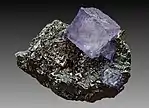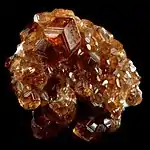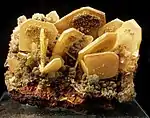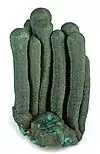Crystal habit
In mineralogy, crystal habit is the characteristic external shape of an individual crystal or crystal group. The habit of a crystal is dependent on its crystallographic form and growth conditions, which generally creates irregularities due to limited space in the crystallizing medium (commonly in rocks).[1][2]

Recognizing the habit can aid in mineral identification and description, as the crystal habit is an external representation of the internal ordered atomic arrangement.[1] Most natural crystals, however, do not display ideal habits and are commonly malformed. Hence, it is also important to describe the quality of the shape of a mineral specimen:
- Euhedral: a crystal that is completely bounded by its characteristic faces, well-formed. Synonymous terms: idiomorphic, automorphic;
- Subhedral: a crystal partially bounded by its characteristic faces and partially by irregular surfaces. Synonymous terms: hypidiomorphic, hypautomorphic;
- Anhedral: a crystal that lacks any of its characteristic faces, completely malformed. Synonymous terms: allotriomorphic, xenomorphic.

Factors influencing habit include: a combination of two or more crystal forms; trace impurities present during growth; crystal twinning and growth conditions (i.e., heat, pressure, space); and specific growth tendencies such as growth striations. Minerals belonging to the same crystal system do not necessarily exhibit the same habit. Some habits of a mineral are unique to its variety and locality: For example, while most sapphires form elongate barrel-shaped crystals, those found in Montana form stout tabular crystals. Ordinarily, the latter habit is seen only in ruby. Sapphire and ruby are both varieties of the same mineral: corundum.
Some minerals may replace other existing minerals while preserving the original's habit, i.e. pseudomorphous replacement. A classic example is tiger's eye quartz, crocidolite asbestos replaced by silica. While quartz typically forms prismatic (elongate, prism-like) crystals, in tiger's eye the original fibrous habit of crocidolite is preserved.
List of crystal habits
| Habit[3][4][5] | Image | Description | Common example(s) |
|---|---|---|---|
| Acicular |  Natrolite Natrolite |
Needle-like, slender and/or tapered | natrolite, rutile[6] |
| Amygdaloidal | _1_(17307955385).jpg.webp) Native copper Native copper |
Like embedded almonds | heulandite, subhedral zircon |
| Bladed |  |
Blade-like, slender and flattened | actinolite, stilbite, kyanite |
| Botryoidal or globular |  |
Grape-like, hemispherical masses | hematite, pyrite, malachite, smithsonite, hemimorphite |
| Columnar |  |
Similar to fibrous: Long, slender prisms often with parallel growth | calcite, gypsum/selenite |
| Coxcomb |  |
Aggregated flaky or tabular crystals closely spaced. | barite, marcasite |
| Cubic |  |
Cube shape | pyrite, galena, halite |
| Dendritic or arborescent |  |
Tree-like, branching in one or more direction from central point | romanechite, magnesite, native copper |
| Dodecahedral |  |
Rhombic dodecahedron, 12-sided | garnet |
| Drusy or encrustation | -Stilbite-Ca-Heulandite-Ca-226327.jpg.webp) |
Aggregate of minute crystals coating a surface or cavity | uvarovite, malachite, azurite |
| Enantiomorphic |  |
Mirror-image habit (i.e. crystal twinning) and optical characteristics; right- and left-handed crystals | quartz, plagioclase, staurolite |
| Equant, stout |  |
Length, width, and breadth roughly equal | olivine, garnet |
| Fibrous (including asbestiform) |  |
Extremely slender prisms | serpentine group, tremolite (i.e. asbestos) |
| Filiform or capillary | .jpg.webp) |
Hair-like or thread-like, extremely fine | many zeolites |
| Foliated or micaceous or lamellar (layered) |  |
Layered structure, parting into thin sheets | muscovite, biotite |
| Granular |  |
Aggregates of anhedral crystals in matrix | bornite, scheelite |
| Hemimorphic |  |
Doubly terminated crystal with two differently shaped ends | hemimorphite, elbaite |
| Hexagonal |  |
Hexagonal prism (six-sided) | quartz, hanksite |
| Hopper crystals |  |
Like cubic, but outer portions of cubes grow faster than inner portions, creating a concavity | halite, calcite, synthetic bismuth |
| Mammillary | .jpg.webp) |
Breast-like: surface formed by intersecting partial spherical shapes, larger version of botryoidal, also concentric layered aggregates | malachite, hematite |
| Massive or compact |  |
Shapeless, no distinctive external crystal shape | limonite, turquoise, cinnabar, realgar |
| Nodular or tuberose |  |
Deposit of roughly spherical form with irregular protuberances | chalcedony |
| Octahedral |  |
Octahedron, square bipyramid (eight-sided) | diamond, fluorite, magnetite |
| Platy |  |
Flat, tablet-shaped, prominent pinnacoid | wulfenite |
| Plumose |  |
Fine, feather-like scales | aurichalcite, boulangerite, mottramite |
| Prismatic |  |
Elongate, prism-like: well-developed crystal faces parallel to the vertical axis | tourmaline, beryl |
| Pseudo-hexagonal |  |
Hexagonal appearance due to cyclic twinning | aragonite, chrysoberyl |
| Radiating or radial or divergent |  |
Radiating outward from a central point without producing a star (crystals are generally separated and have different lengths) | stibnite |
| Reniform or colloform |  |
Similar to botryoidal/mamillary: intersecting kidney-shaped masses | hematite, pyrolusite, greenockite |
| Reticulated |  |
Crystals forming net-like intergrowths | cerussite |
| Rosette or lenticular (lens shaped crystals) |  |
Platy, radiating rose-like aggregate | gypsum, barite (i.e. desert rose) |
| Sphenoid |  |
Wedge-shaped | sphene |
| Stalactitic |  |
Forming as stalactites or stalagmites; cylindrical or cone-shaped | calcite, goethite, malachite |
| Stellate |  |
Star-like, radial aggregates radiating from a "star"-like point to produce gross spheres (crystals are not or weakly separated and have similar lengths) | pyrophyllite, aragonite, wavellite, pyrite suns |
| Striated |  |
Not a habit per se, but a condition of lines that can grow on certain crystal faces on certain minerals | tourmaline, pyrite, quartz, feldspar, sphalerite |
| Tabular (also stubby or blocky) |  |
More elongated than equant, slightly longer than wide, flat tablet-shaped | feldspar, topaz |
| Tetrahedral |  |
Tetrahedron, triangular pyramid (four-sided) | tetrahedrite, spinel, magnetite |
| Wheat sheaf |  |
Aggregates resembling hand-reaped wheat sheaves | stilbite |
See also
- Abnormal grain growth
- Grain growth
- Crystal structure
References
- Klein, Cornelis, 2007, Minerals and Rocks: Exercises in Crystal and Mineral Chemistry, Crystallography, X-ray Powder Diffraction, Mineral and Rock Identification, and Ore Mineralogy, Wiley, third edition, ISBN 978-0471772774
- Wenk, Hans-Rudolph and Andrei Bulakh, 2004, Minerals: Their Constitution and Origin, Cambridge, first edition, ISBN 978-0521529587
- "What are descriptive crystal habits". Archived from the original on 2017-07-07. Retrieved 2009-04-06.
- Crystal Habit Archived 2009-04-12 at the Wayback Machine
- Habit
- Hanaor, D.A.H; Xu, W; Ferry, M; Sorrell, CC (2012). "Abnormal grain growth of rutile TiO2 induced by ZrSiO4". Journal of Crystal Growth. 359: 83–91. arXiv:1303.2761. Bibcode:2012JCrGr.359...83H. doi:10.1016/j.jcrysgro.2012.08.015. S2CID 94096447.